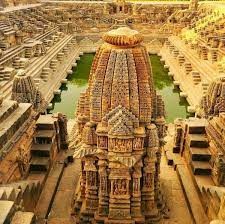Published on: December 21, 2022
UNESCO Tentative list
UNESCO Tentative list
Why in news? Gujarat’s Vadnagar town, the iconic Sun Temple at Modhera, and the rock cut sculptures of Unakoti in Tripura have been added to the tentative list of UNCESO World Heritage Sites
Highlights
- The UNESCO tentative list is an “inventory of those properties which each State Party intends to consider for nomination”.
- India now has 52 sites on UNESCO Tentative List indicating rich cultural and natural wealth of India and shows huge diversity of our heritage
Sun Temple, Modhera
- It is a Hindu temple dedicated to the solar deity Surya
- Location : Modhera village of Mehsana district, Gujarat, India.
- Period: During the reign of Bhima I of the Chaulukya dynasty.
- No worship is offered now and is protected monument maintained by Archaeological Survey of India.
- Architecture : Māru-Gurjara style
- The temple complex has three components:
- Gūḍhamanḍapa, the shrine hall
- Sabhamanḍapa, the assembly hall
- Kunḍa, the reservoir.
The halls have intricately carved exterior and pillars. The reservoir has steps to reach the bottom and numerous small shrines.
- The temple is built on 23.6° latitude (approximately near Tropic of Cancer).
- The temple is the Monument of National Importance and is maintained by the Archeological Survey of India
Vadnagar
- It is a town and municipality in the Mehsana district of the state of Gujarat in India.
- Its ancient name was Anartapura(Anandapura).
- Buddhist location visited by Xuanzang in 640 C.E. Historian and archaeologist Alexander Cunningham has identified Anandapura with the town of Vadnagar.
- A multi-layered historic town, Vadnagar has a recorded past stretching back to nearly 8th century BC.
- The town still retains a large number of historic buildings that are primarily religious and residential in nature.
Unkoti Hill
- It is a sculptural emblem and ancient Shaivite place
- Location : Unakoti District, in the Kailashahar Subdivision of the North-eastern Indian state of Tripura
- Hosts approximately ninety-nine lakh ninety-nine thousand nine hundred and ninety-nine rock carvings figures and images of gods and goddesses.
- Place of worship with huge rock reliefs celebrating Shiva.
- Festival: Big fair popularly known as Ashokastami Mela
- Apart from shiva, Durga standing on a lion and another female figure on the other side in addition, three enormous images of Nandi Bull are found half-buried in the ground.
About World Heritage Sites in India
- Designation Organization : UNESCO
- Outstanding universal value to cultural or natural heritage which have been nominated by countries which are signatories to the UNESCO World Heritage Convention, established in 1972.
- Cultural heritage:
- Consists of monuments (architectural works, monumental sculptures, or inscriptions)
- Groups of buildings, and sites (including archaeological sites).
- Natural features:
- consisting of (physical and biological formations)
- Geological and physiographical formations (including habitats of threatened species of animals and plants)
- Natural sites important from the point of view of science, conservation or natural beauty, are defined as natural heritage.
- Indian Sites: 40
- Out of these, 32 are cultural, 7 are natural, and one, the Khangchendzonga National Park, is of mixed type.
- India has the sixth largest number of sites in the world.
- First sites : Ajanta Caves, Ellora Caves, Agra Fort, and Taj Mahal,
- Recent: Dholavira(2021).
Tentative list
- In addition to the World Heritage List, member states can maintain a list of tentative sites that they may consider for nomination.
Nominations for the World Heritage List are only accepted if the site was previously listed on the tentative list.

